May 15, 2025 | 23:34 GMT +7
May 15, 2025 | 23:34 GMT +7
Hotline: 0913.378.918
May 15, 2025 | 23:34 GMT +7
Hotline: 0913.378.918
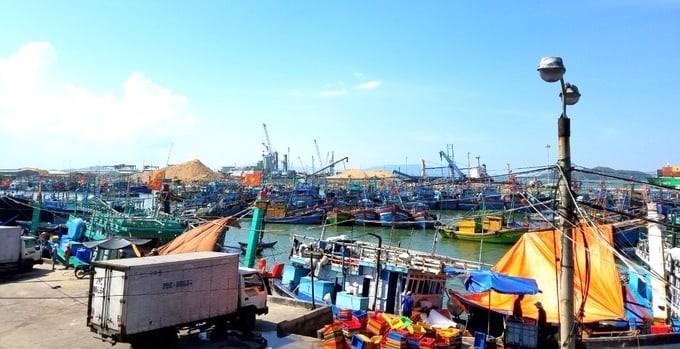
Quy Nhon fishing port has a total output of seafood entering the port estimated at 37,000 tons/year. Photo: V.D.T.
Binh Dinh currently has 5,954 fishing vessels at sea. To serve this fishing fleet, the province now has three Class-II fishing ports announced according to regulations, including: Quy Nhon fishing port (Quy Nhon city), De Gi fishing port (Phu Cat district), and Tam Quan fishing port (Hoai Nhon town).
According to Mr. Tran Van Phuc, Director of Binh Dinh Department of Agriculture and Rural Development, Quy Nhon fishing port was invested in construction and expansion, completed, and put into operation in 2012. The port was announced by the Ministry of Agriculture and Rural Development (MARD) as a designated fishing port with a sufficient system to certify the origin of exploited seafood by 2020. The total port water area is 20.6ha, the depth of the channel to the port is 7m, and the port land area is 3.5ha. Quy Nhon fishing port has now mechanized loading and unloading over 70% of goods. The average number of fishing vessels passing through the port is 10,000 times/year; loading and unloading capacity is 40,000 tons/year; and the total output of seafood entering the port is estimated at 37,000 tons/year.
De Gi fishing port was invested in construction and expansion, completed, and put into use in 2014. The port was announced by MARD as a designated fishing port with a sufficient system to certify the origin of aquatic products by 2020. De Gi fishing port has a total port water area of over 10ha, a channel depth of 5m, and a port land area of 2.5ha. Currently, over 70% of loading and unloading goods at this port has been mechanized. The average number of fishing vessels passing through the port is 7,300 times/year; loading and unloading capacity is 20,000 tons/year; and the total output of seafood entering the port is estimated at 15,000 tons/year.
Tam Quan fishing port was announced by MARD as a designated fishing port with a sufficient system to confirm the origin of exploited seafood by 2021. The total port water area is 10ha, the channel depth is 5m, and the port land area is 3.8ha. The number of fishing vessels passing through the port is 20,000 times/year; loading and unloading capacity is 40,000 tons/year; and the total output of seafood entering the port is estimated at 20,000 tons/year.
According to Mr. Nguyen Huu Nghia, Director of the Binh Dinh Sub-Department of Fisheries, although fisheries infrastructure and logistics services in Binh Dinh have been invested in, they are still not commensurate with the potential for fishery economic development. Particularly, current ship anchoring areas are overloaded and lack investment and construction capital. Therefore, the locality is in dire need of central support to upgrade fishing port infrastructure and anchoring areas to meet standards and the needs of fishing vessels in the province and in the region.
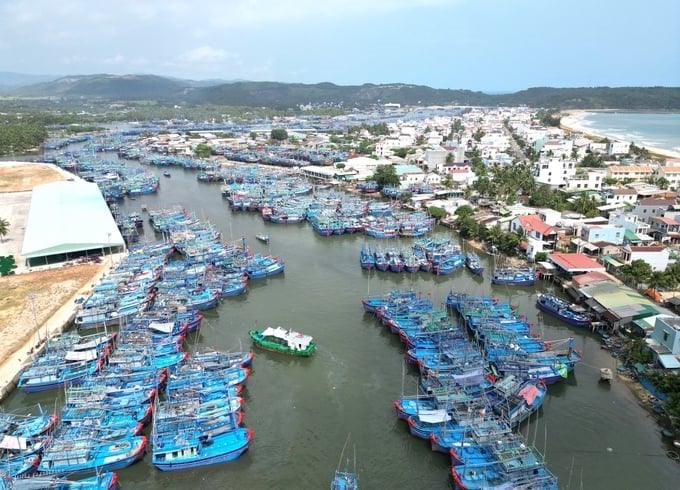
Currently, the Prime Minister has approved the guidelines for investing in a storm shelter zone at the regional level in Tam Quan. Photo: V.D.T.
“Binh Dinh currently has 5,954 fishing vessels, excluding about 200–300 fishing vessels of Quang Ngai fishermen, but the capacity at anchoring areas is only enough to accommodate 5,300 ships. Although the De Gi Lagoon anchoring area has been built with a breakwater with a length of 400m to prevent sand, the area at the beginning of the breakwater is still filled with sand every year, making it difficult for boats to enter and exit. As for the Tam Quan anchoring area, it is currently overloaded. Although the local government has dredged and cleared the channel every year, that is not a sustainable solution," said Mr. Nghia.
According to Mr. Tran Van Phuc, Director of Binh Dinh Department of Agriculture and Rural Development, with the guideline of investing in irrigation and fisheries projects registered to use MARD’s capital in the period 2021-2025, Binh Dinh will implement the project of a storm shelter zone combined with Tam Quan fishing port in the coming time. This is the first priority project in the fisheries field. The project’s total investment is estimated at VND 472 billion, of which the central capital supports 90% (equivalent to VND 425 billion) and the budget capital of Binh Dinh province supports 10% (equivalent to VND 47 billion). Currently, the Prime Minister has approved the guidelines for investing in a storm shelter zone at the regional level in Tam Quan according to Decision 592/QD-TTg dated May 30, 2023.
Besides, in the coming time, Binh Dinh plans to complete the infrastructure of fishing ports to meet Class-I fishing port standards and form 11 logistics service areas to meet the needs of fishing vessels, especially during the rainy and stormy season. Binh Dinh determines that plan as a premise to develop the province's ocean economy as well as to meet the requirements of the European Commission (EC) to overcome the IUU "yellow card".
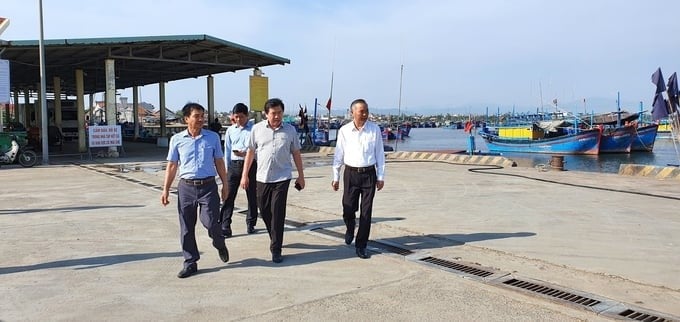
Fisheries infrastructure and logistics services in Binh Dinh have been invested in but are not commensurate with the potential for fishery economic development. Photo: V.D.T.
Binh Dinh will also renovate and expand to a regional anchoring area that can accommodate over 2,000 ships with a capacity of 400–1,000 CV to shelter from storms, helping ensure safety for fishermen and their assets in the province and in the region during the rainy and stormy season. In addition, the province develops logistics services for fishing vessels to go fishing while improving monitoring capacity and supporting cruise monitoring equipment for fishermen.
The project of the De Gi Lagoon storm shelter zone combined with the De Gi fishing port (Phu Cat district) is the second priority in the fisheries field to be implemented in Binh Dinh. This project has a total estimated investment of VND 450 billion, of which the central capital supports 90% (equivalent to VND 405 billion) and the provincial budget capital supports 10% (equivalent to VND 45 billion).
According to Mr. Phuc, MARD has now approved the investment guidelines for the De Gi Lagoon Storm Shelter Zone project according to Decision No. 3211/QD-BNN-KH dated July 20, 2021, with an investment scale of about 2,000 ships with a capacity of 300 CV. Investment items include repairing and upgrading the breakwater south of the channel. Dredging the channel with an estimated length of 4.7km and building an anchoring area of about 57ha, with a total expected investment of VND 320 billion (including VND 300 billion from the central budget through MARD and VND 20 billion from the provincial budget for clearance compensation).

The Tam Quan estuary channel (Hoai Nhon town, Binh Dinh) is regularly filled with sediment. Photo: V.D.T.
In the future, the fishing port system in Binh Dinh province will enjoy synchronous infrastructure investment to meet the development needs of fisheries while improving management and natural disaster prevention capacity in the area. This is also a solution to ensure monitoring of seafood output at fishing ports to meet the EC’s requirements in an effort to remove the IUU "yellow card".
However, a serious shortage of fisheries logistics services with the dependence on private fishing wharves at Tam Quan fishing port is also the concern of the functional sector and government in Binh Dinh.
Mr. Nguyen Huu Nghia, Director of the Binh Dinh Sub-Department of Fisheries, said that due to the above actual situation, it is still difficult to monitor the output of fishing vessels landing at fishing ports. According to regulations in Circular No. 21/2018/TT-BNNPTNT, designated fishing ports must monitor 100% of fishing vessels landing to sell products, thus requiring a huge human resource. However, the fishing port is a non-business unit with the mechanism of financial autonomy, so there is not enough funding for hiring labor.

Monitoring exploited seafood at Quy Nhon fishing port (Binh Dinh). Photo: V.D.T.
Mr. Nghia cited the difficulties of Binh Dinh Fishing Port Management Board as an example: "Binh Dinh Fishing Port Management Board is a revenue-generating public non-business unit, directly under the Department of Agriculture and Rural Development, and self-ensuring all operating costs. This unit has 46 officers and employees in charge of managing Quy Nhon fishing port, De Gi fishing port, Tan Phung fishing wharf, and Nhon Ly fishing wharf. The number of human resources mentioned above is like 'a drop in the ocean' compared to the amount of work that must be done.”
“To ensure that fishing ports monitor the seafood output of 100% of vessels landing at the port and confirm the exploited seafood raw materials, the Binh Dinh functional sector requires fishing ports to arrange large human resources for implementation. Therefore, the functional sector proposes to order public services to monitor the output of ships landing at fishing ports so that the Fishing Port Management Boards have funds for implementation," said Mr. Nguyen Huu Nghia, Director of the Binh Dinh Sub-Department of Fisheries.
Translated by Huyen Vu Thu

(VAN) Data from 10,000 farming households will help professionalize production organization and support the implementation of the One Million Hectares Program for High-Quality, Low-Emission Rice Cultivation.

(VAN) FAO Director-General QU Dongyu marks International Day of Plant Health at NENA conference.

(VAN) Deputy Minister of Agriculture and Environment Hoang Trung affirmed that floriculture and ornamental plants are a growing industry that receives significant global attention.

(VAN) The three staple crops dominating modern diets – corn, rice and wheat – are familiar to Americans. However, fourth place is held by a dark horse: cassava.
/2025/05/10/4037-3-223011_495.jpg)
(VAN) Remote sensing technology is becoming an indispensable tool in monitoring resources, developing modern agriculture, and protecting the environment in Vietnam.
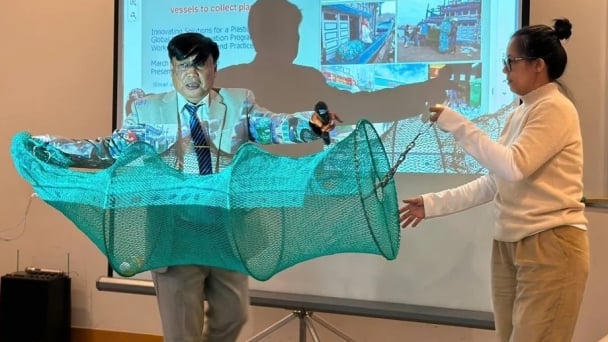
(VAN) The trash bag used on fishing vessels can withstand rough sea conditions, including level 8 to level 10 winds and waves. Notably, it can be hung anywhere on the boat.
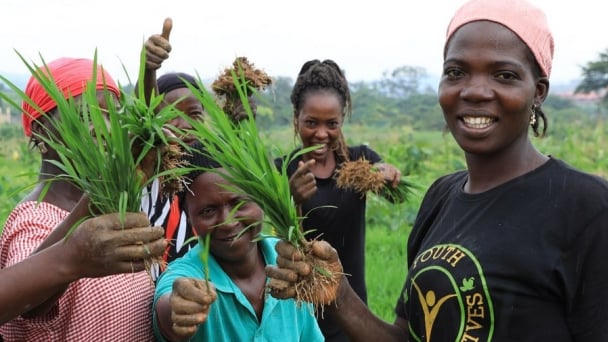
(VAN) African leaders launched the Kampala Declaration on Building Resilient and Sustainable Agrifood Systems in Africa, marking a bold step toward transforming the continent's agriculture.